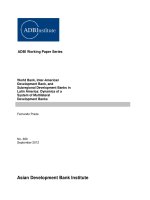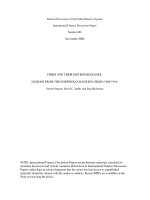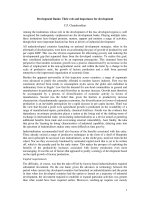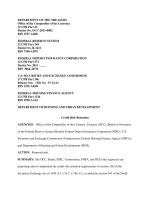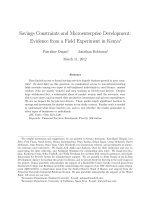bretton woods institutions and multilateral development banks 2018
Bạn đang xem bản rút gọn của tài liệu. Xem và tải ngay bản đầy đủ của tài liệu tại đây (966.22 KB, 17 trang )
Development Finance, MPP, VJU
Prof. Koji Fujimoto
Class 4 Bretton Woods Institutions and Multilateral Development Banks
1. The Birth of the Bretton Woods Institutions (Refer to Reference/Appendix 1)
What did happen in the process of creating the Bretton Woods Institutions
vis-à-vis the International Trade Organization (ITO) and the United Nations
(UN)?
2. Impact of the Bretton Woods Institutions
Have the Bretton Woods Institutions contributed to world economic
stabilization and development?
3. Visions and Realities
How have visions and realities of the Bretton Woods institutions deferred over
time?
(1) The International Monetary Fund (IMF)
(2) The World Bank
(3) The General Agreement on Tariffs and Trade (GATT in place of ITO)
4. Fatal Flaws
Why the Bretton Woods Institutions are not functioning as expected today?
What went wrong with the Bretton Woods Institutions?
5. A Blueprint for Reform
(1) IMF
What kinds of specific reform measures are thinkable?
(2) The World Bank
What kinds of specific reform measures are considered?
(Study Reference 1/Appendix 1 “Chapter 14 of Mahbub ul Haq’s Reflection on
Human Development, 1995.”)
6. Reform Proposals for IMF and Multilateral Development Banks (Appendix 2)
How should IMF and MDBs be reformed? Comment on Appendix 2.
(1) Meltzer Report (2000)
(2) Lawrence Summer’s Proposal (1999)
(Study Reference 2/Appendix 2 “A Comparison of Reform Proposals for the IMF
and Multilateral Development Banks.”)
1
Development Finance, MPP, VJU
Prof. Koji Fujimoto
Bretton Woods Institutions Today
1. International Monetary Fund: IMF
Headquarters: 700 19th Street, N.W., Washington D.C. 20431, U.S.A.
Establishment: Established in December 1945.
Operation started in March 1947.
Purposes (Article I - Purposes):
(i) To promote international monetary cooperation;
(ii) To facilitate the expansion and balanced growth of international trade;
(iii ) To promote exchange stability;
(iv) To assist in the establishment of a multilateral system of payments; and
(v) To make its resources available (under adequate safeguards) to members
experiencing balance of payment difficulties.
Membership: 189 countries (as of 2017). Japan joined IMF in August 1952.
Organization:
(1) Board of Governors
The Board of Governors is the highest decision-making body of the IMF. It
consists of one governor and one alternate governor for each member country.
The governor is appointed by the member country and is usually the minister of
finance or the governor of the central bank. All powers are vested in the Board of
Governors. The Board of Governors may delegate to the Executive Board all
except certain reserved powers. The Board of Governors normally meets once a
year at the IMF-World Bank Annual Meetings.
(2) Executive Board
The Executive Board is composed of 25 Executive Directors and their
Alternates appointed (6) or elected (19) by member countries.
The day-to-day work of the IMF is conducted at its Washington DC
headquarters by its 24-member Executive Board; this work is guided by the IMFC
and supported by the IMF’s professional staff. The Managing Director is the Head
of IMF staff and Chairman of the Executive Board.
The Executive Board meets regularly and normally three times a week.
(3) Managing Director
Ms Christine Lagarde from France is the Managing Director. She succeeded Mr.
Dominique Strauss-Kahn from France on July 5, 2011. The term is 5 years.
2
Development Finance, MPP, VJU
Prof. Koji Fujimoto
(4) International Monetary and Financial Committee
The IMFC was established on September 30, 1999, by a resolution of the IMF
Board of Governors, to replace the Interim Committee of the Board of Governors
on the International Monetary System (usually known simply as the Interim
Committee), which had been established in 1974. As the Interim Committee did,
the IMFC usually meets twice a year, in September or October before the
IMT-World Bank Annual Meetings, and in March or April at what are referred to
as the Spring Meetings.
Like the Interim Committee, the IMFC has the responsibility of advising, and
reporting to, the Board of Governors on matters relating to the Board of
Governors’ functions supervising the management and adaptation of the
international monetary and financial system, including the operation of the
adjustment process, and in this connection reviewing developments in global
liquidity and the transfer of resources to developing countries; considering
proposals by the Executive Board to amend the articles of Agreement; and dealing
with disturbances that might threaten the system.
The IMFC has 24 members who are Governors of the IMF (generally ministers
of finance or central bank governors). The membership reflects the composition of
the IMF’s Executive Board: each member country that appoints, and each group
of member countries that elects, an Executive Director appoints a member of the
IMFC. A number of international institutions, including the World Bank,
participate as observers in the IMFC’s meeting.
(5) Development Committee
The Joint Ministerial Committee of the Boards of Governors of the Bank and
Fund on the Transfer of Real Resources to Developing Countries, better known as
the Development Committee, was established in October 1974 to advise the Board
of Governors of the IMF and World Bank on critical development issues and on
the financial resources required to promote economic development in developing
countries. Over the years, the Committee has interpreted its mandate to include
trade and global environmental issues in addition to traditional development
matters. The Committee usually meets twice a year, just like the IMFC.
The Development Committee has 24 members (usually ministers of finance or
development) who together represent the full membership of the IMF and World
Bank. Each is appointed for periods of two years by one of the countries or groups
of countries that designates a member to the World Bank’s or the IMF’s Executive
Board. In addition, there is a chairman. Altogether, there are 25 members in the
3
Development Finance, MPP, VJU
Prof. Koji Fujimoto
Committee.
(6) Staff
There are approximately 2,700 employees from 148 countries (as of 2017).
Resources:
(1) Accounts
(i) General Department Accounts (General Resources Account, Special Disbursement
Account and Investment Account)
(ii) SDR Department Account
(iii) Poverty Reduction and Growth Facility and Exogenous Shocks Facility Trust
Account
(iv) PRGF-HIPC Trust and Related Accounts
(v) The Other Administered Accounts
(2) IMF Quotas
Quota subscriptions generate most of the IMF’s financial resources. Each member
of the IMF is assigned a quota, based broadly on its relative size in the world
economy. A member’s quota determines its maximum financial commitment to the
IMF and its voting power, and has a bearing on its access to IMF financing. A
member must pay its subscription in full upon joining the Fund: up to 25% must be
paid in SDRs or widely accepted currencies (such as the U.S. dollar, the euro, the
yen, or the pound sterling), while the rest is paid in the member’s own currency.
Total quotas as of February 2017 were SDR 475.4 billion (about US$668 billion).
Table 1 Quota and Votes of Major Countries as of 2017
Country
U.S.A.
Japan
China
Germany
U.K.
France
Total
Quota (Millions of SDRs)
82,994.2 (17.46%)
30,820.5 (6.48%)
30,482.9 (6.41%)
26,634.4 (5.60%)
20,155.1 (4.24%)
20,155.1 (4.24%)
475,383 (100%)
Votes
831,406 (16.53%)
309,669 (6.16%)
306,293 (6.09%)
267,808 (5.32%)
203,015 (4.04%)
203,015 (4.04%)
5,030,526 (100%)
(3) IMF Borrowing Arrangements
While quota subscriptions of member countries are its main source of financing,
the IMF can activate supplementary borrowing arrangements if it believes that
resources might fall short of members’ needs. Through the General Arrangements to
4
Development Finance, MPP, VJU
Prof. Koji Fujimoto
Borrow (GAB) and the New Arrangements to Borrow (NAB), a number of member
countries stand ready to lend additional funds to the IMF.
(i) GAB since 1962
GAB enables the IMF to borrow specified amounts of currencies from 11
industrial countries (or their central banks), under certain circumstances, at
market-related rates of interest. The potential amount of credit available to the
IMF under GAB totals SDR 17 billion (about $25 billion), with an additional
SDR 1.5 billion available under an associated arrangement with Saudi Arabia.
(ii) NAB since 1998
The Mexican financial crisis caused the creation of NAB. NAB is a set of
credit arrangements between the IMF and 26 members and institutions to provide
supplementary resources to the IMF to forestall or cope with an impairment of the
international monetary system or to deal with an exceptional threat to the stability
of that system.
NAB does not replace GAB. However, NAB would typically be the first and
principal resource in the event of a need to provide supplementary resources to
the IMF. The maximum amount or resources available to the IMF under both
borrowing arrangements is SDR 34 billion (about $50 billion).
Lending:
The core responsibility of the IMF is to provide loans to countries experiencing
balance of payment problems. This financial assistance enables countries to rebuild their
international reserves; stabilize their currencies; continue paying for imports; and
restore conditions for strong economic growth. Unlike development banks, the IMF
does not lend for specific projects.
(1) Concessional Facilities for LICs
► Extended Credit Facility (ECF)
ECF was introduced in January 2010 to succeed the Poverty Reduction and
Growth Facility PRGF) as the Fund’s main tool for providing medium-term
support to LICs with protracted balance of payments problems. Financing under
the ECF currently carries a zero interest rate, with a grace period of 5½ years, and
a final maturity of 10 years.
► Standby Credit Facility (SCF)
SCF was introduced in January 2010 to provide financial assistance to LICs
with short-term balance of payments needs. The SCF replaces the High-Access
Component of the Exogenous Shocks Facility (ESF), and can be used in a wide
range of circumstances, including on a precautionary basis. Financing under the
5
Development Finance, MPP, VJU
Prof. Koji Fujimoto
SCF currently carries a zero interest rate, with a grace period of 4 years, and a
final maturity of 8 years.
► Rapid Credit Facility (RCF)
RCF was introduced in January 2010 to provide rapid financial assistance with
limited conditionality to LICs facing an urgent balance of payments need. The
RCF streamlines the Fund’s emergency assistance for LICs, and can be used
flexibly in a wide range of circumstances. Financing under the RFC currently
carries a zero interest rate, has a grace period of 5½ years, and a final maturity of
10 years.
(2) General Facilities
► Stand-By Arrangements (SBA)
The SBA is designed to help countries address short-term balance of payment
problems. The bulk of Fund assistance to middle-income countries is provided
through SBAs. The length of a SBA is typically 12 – 24 months, and repayment
is normally expected within 3¼ – 5 years. SBAs may be provided on a
precautionary basis – where countries choose not to draw upon approved amounts
to retain the option to do so if conditions deteriorate – both within the normal
access limits and in cases of exceptional access. The SBA provides for flexibility
with respect to phasing, with front-loaded access where appropriate.
► Extended Fund Facility (EFF)
The EFF was established in 1974 to help countries address their long-term
balance of payments problems that require fundamental economic reforms.
Arrangements under the EFF are thus longer than SBAs – usually 3 years.
Repayment is normally expected within 4¼ – 10 years.
► Supplemental Reserve Facility (SRF) ⇒ Abolished in March 2009
SRF was introduced in 1997 to meet a need for very short-term financing on a
large scale. The motivation for the SRF was the sudden loss of market confidence
experienced by emerging market economies in the 1990s, which led to massive
outflows of capital and required financing on a much large scale than the IMF had
previously provided. Countries are expected to repay loans within 2 – 2½ years,
but may request an extension of up to an additional six months. All SRF loans
carry a substantial surcharge of 3 – 5% points.
► Compensatory Financing Facility (CFF) ⇒ Abolished in March 2009
CFF was established in 1963 to assist countries experiencing either a sudden
shortfall in export earnings or an increase in the cost of cereal imports, often
caused by fluctuating world commodity prices. Financial terms are similar to
6
Development Finance, MPP, VJU
Prof. Koji Fujimoto
those applying to SBA, except that CFF loans carry no surcharge.
► Emergency Assistance (EA)
EA was established in 1962 to assist countries that have experienced a natural
disaster or are emerging from conflict. Emergency loans are subject to the basic
rate of charge, although interest subsidies are available for some countries,
subject to availability. Loans must be repaid within 3¼ – 5 years.
► Flexible Credit Line (FCL)
FCL was introduced in 2009 to support countries with very strong
fundamentals, policies, and track records of policy implementation and is
particularly useful for crisis prevention purposes. FCL arrangements are approved
for countries meeting pre-set qualification criteria. The length of the FCL is 6
months or 1 year (with a mid-term review) and the repayment period the same as
for the SBA. Access is determined on a case-by-case basis, is no subject to the
normal access limits, and is available in a single up-front disbursement rather than
phased. Disbursements under the FCL are not conditioned on implementation of
specific policy understandings as is the case under the SBA. There is flexibility to
draw o the credit line at the time it is approved, or it may be treated as
precautionary.
2. International Bank for Reconstruction and Development: IBRD (also known as
the World Bank)
Headquarters: 1818 H Street, N.W. Washington D.C. 20433, U.S.A
Establishment: Established in December 1945.
Operations started in June 1946.
Purposes:
(i) To support the long-term human and social development needs that
private creditors do not finance
(ii) Preserve borrowers’ financial strength by providing support in crisis
periods, which is when poor people are most adversely affected;
(iii) To use the leverage of financing to promote key policy and institutional
reforms (such as safety nets or anticorruption reforms);
(iv) To create a favorable investment climate in order to catalyze the
provision of private capital;
(v) To provide financial support (in the form of grants made available from
the IBRD’s net income) in areas that are critical to the well-being of
7
Development Finance, MPP, VJU
Prof. Koji Fujimoto
poor people in all countries.
Membership: 189 member countries (as of 2017). Japan joined in 1952.
Japan borrowed from the IBRD $822.9 million (31 loans between 1953
and 1966).
Organization:
(1) Board of Governors:
Shareholders are represented by the Board of Governors, who are the ultimate
policy makers at the World Bank. Generally, the governors are member countries’
ministers of finance or ministers of development. They meet once a year at the
Annual Meeting of the Board of Governors of the World Bank Group and the
International Monetary Fund.
Because the governors only meet annually, they delegate specific duties to 24
Executive Directors, who work on-site at the World Bank. The five largest
shareholders, France, Germany, Japan, the United Kingdom and the United States
appoint an executive director, while other member countries are represented by 19
rotated executive directors.
(2) Board of Executive Directors:
The World Bank Group Board of Executive Directors are responsible for
conducting the day-to-day business of the World Bank. The Boards are composed
of 24 Execute Directors, who are appointed or elected by member countries or by
groups of countries, and the resident, who serves as its Chairman. Regular
meetings are usually held once or twice a week on Tuesdays and Thursdays.
(3) President:
The present President of the World Bank is Mr. Jim Yong Kim, who succeeded
Mr. Robert B. Zoellick in April 2012. The US President nominates the position.
The term can be five years and is renewable.
(4) World Bank Group:
The World Bank Group consists of the International Bank for Reconstruction
and Development (IBRD or World Bank), the International Development
Association (IDA), the International Finance Corporation (IFC), the Multilateral
Investment Guarantee Agency (MIGA) and the International Center for Settlement
of Investment Disputes (ICSID). The first four institutions maintain a Board of
Directors. The Executive Directors serving on these Boards are usually the same.
Under the Articles of IDA and IFC, Executive Directors and Alternate Directors of
the Bank serve ex officio as Executive Directors and Alternates of IDA and IFC, as
long as the country that appoints them, or any one of the countries that have
8
Development Finance, MPP, VJU
Prof. Koji Fujimoto
elected them, is a member of IFC and IDA. Furthermore, it is customary for the
Directors of MIGA to be the same individuals as the Executive Directors of the
World Bank.
(5) Development Committee: (Refer to the IMF)
(6) Staff: Approximately 10,000 (as of 2017).
Table 1 Subscribed Capital, Paid-in Capital and Voting Power of Major Countries
S u b s c r i b e
U . S . A . 4 3 , 1 6 9 .
J a p a n
1 9 , 9 5 8 .
C h i n a
1 2 , 8 5 9 .
G e r m a n y 1 1 , 6 5 0 .
F r a n c e
1 0 , 4 4 5 .
U . K .
1 0 , 4 4 5 .
d
0
3
0
2
9
9
PC aa ip di -t ia nl
0
2 , 6 7 0
0
1 , 2 2 2
0
7 7 4 .
0
7 1 7 .
0
6 4 4 .
0
664
C a p Ni to a. l o f V o St he as r e o f V o t e s
. 6 0
3 5 8 , 5 0 3
1 6 . 1 6
. 2 0
1 6 6 , 0 9 9
7 . 4 9
8
1 0 7 , 2 4 9
4 . 8 3
9
9 7 , 2 2 9
4 . 3 8
8
8 7 , 2 4 6
3 . 9 3
87,246
3.93
Lending:
(1) Magnitude of Operation
World Bank Commitments and Disbursements
IBRD Operational Summary, Fiscal Years 2012-16
millions of dollars
IBRD
Commitments
Of which development policy lending
Gross disbursements
Of which development policy lending
Principal repayments (including prepayments)
Net disbursements
Loans outstanding
Undisbursed loans
Allocable income
Usable equity
Equity-to-loans ratio
2012
20,582
10,333
19,777
9,052
11,970
7,806
136,325
62,916
998
37,636
27.0%
2013
15,249
7,080
16,030
5,972
9,470
6,361
143,776
61,306
968
39,711
26.8%
2014
18,604
7,997
18,761
9,786
9,805
8,956
154,021
58,449
769
40,467
25.7%
2015
23,528
7,207
19,012
8,935
9,005
10,007
157,012
60,211
686
40,195
25.1%
2016
29,729
13,210
22,532
12,068
9,327
13,204
169,655
65,909
593
39,424
22.7%
2014
22,239
2,489
13,432
2,644
3,636
9,878
136,011
46,844
6,983
2,645
2015
18,966
2,597
12,905
2,005
4,085
8,820
130,878
47,288
6,637
2,319
2016
16,171
1,890
13,191
2,564
4,327
8,806
136,735
49,476
6,099
1,232
IDA Operational Summary, Fiscal Years 2012-16
millions of dollars
IDA
Commitments
Of which development policy lending
Gross disbursements
Of which development policy lending
Principal repayments (including prepayments)
Net disbursements
Credits outstanding
Undisbursed credits
Undisbursed grants
Development grant expenses
2012
14,753
1,827
11,061
2,092
4,023
7,037
123,576
37,144
6,161
2,062
9
2013
16,298
1,954
11,228
1,662
3,845
7,371
125,135
39,765
6,436
2,380
( % )
Development Finance, MPP, VJU
Prof. Koji Fujimoto
World Bank Lending by Theme, Fiscal Years 2012-16
millions of dollars
Theme
IBRD
Economic Management
Environment and Natural Resources Management
Financial and Private Sector Development
Human Development
Public Sector Governance
Rule of Law
Rural Development
Social Development, Gender, and Inclusion
Social Protection and Risk Management
Trade and Integration
Urban Development
IBRD Total
2012
2013
2014
2015
2016
1,160
2,429
3,313
2,672
2,754
98
1,921
405
2,244
1,437
2,150
20,582
353
1,308
2,700
1,534
2,082
448
1,771
753
2,025
1,031
1,243
15,249
461
1,231
5,102
1,803
3,441
244
1,844
713
1,230
403
2,132
18,604
715
1,836
6,214
1,916
1,508
730
1,745
1,165
3,357
838
3,503
23,528
1,340
3,758
6,838
2,652
4,745
406
2,974
449
2,563
1,555
2,447
29,729
IDA
Economic Management
Environment and Natural Resources Management
Financial and Private Sector Development
Human Development
Public Sector Governance
Rule of Law
Rural Development
Social Development, Gender, and Inclusion
Social Protection and Risk Management
Trade and Integration
Urban Development
IDA Total
133
1,568
1,430
2,289
1,281
28
3,521
842
1,258
435
1,967
14,753
131
1,163
1,680
2,814
1,708
142
2,880
556
1,931
1,676
1,618
16,298
495
2,652
2,926
3,389
1,811
47
4,593
352
2,356
1,239
2,380
22,239
430
1,329
2,282
4,128
1,325
95
3,337
570
3,220
889
1,362
18,966
546
1,122
2,385
2,262
1,124
61
3,131
534
2,882
698
1,424
16,171
World Bank Total (IBRD + IDA)
35,335
31,547
40,843
42,495
45,900
Note: Numbers may not add to totals because of rounding.
World Bank Lending by Sector, Fiscal Years 2012-16
millions of dollars
Sector
IBRD
Agriculture, Fishing, and Forestry
Education
Energy and Mining
Finance
Health and Other Social Services
Industry and Trade
Information and Communications
Public Administration, Law, and Justice
Transportation
Water, Sanitation, and Flood Protection
IBRD Total
2012
2013
2014
2015
2016
1,163
1,296
2,848
1,410
2,489
713
94
5,381
3,379
1,807
20,582
851
1,065
1,208
1,609
1,822
747
102
4,405
2,600
840
15,249
801
1,123
2,356
1,293
1,598
1,054
262
4,806
4,032
1,279
18,604
797
1,477
3,150
3,404
2,949
1,653
77
4,318
3,086
2,616
23,528
547
1,754
4,557
2,634
2,399
3,426
186
5,775
4,330
4,121
29,729
IDA
Agriculture, Fishing, and Forestry
Education
Energy and Mining
Finance
Health and Other Social Services
Industry and Trade
Information and Communications
Public Administration, Law, and Justice
Transportation
Water, Sanitation, and Flood Protection
IDA Total
1,971
1,663
2,151
354
1,701
638
63
3,347
1,066
1,798
14,753
1,261
1,666
2,071
446
2,541
685
126
3,586
2,535
1,381
16,298
2,257
2,334
4,333
691
1,755
753
119
4,031
2,914
3,052
22,239
2,230
2,057
1,360
649
3,698
659
245
3,862
2,064
2,144
18,966
1,657
1,309
2,645
458
3,303
729
61
2,836
2,039
1,132
16,171
World Bank Total (IBRD + IDA)
35,335
31,547
40,843
42,495
45,900
Note: Numbers may not add to totals because of rounding.
10
Development Finance, MPP, VJU
Prof. Koji Fujimoto
(2) Terms and Conditions of IBRD Loans and IDA Credits
Through the IBRD and IDA, two basic type of loans and credits are offered,
namely investment loans and development policy loans. Investment loans are made
to countries for goods, works and services in support of economic and social
development projects in a broad range of economic and social sectors. Development
policy loans (formally known as adjustment loans) provide quick-disbursing
financing to support countries’ policy and institutional reforms.
(i) IBRD Loans
See “IBRD Lending Rates and Loan Charges” of the World Bank Treasury
(ii) IDA Loans
See “IDA Credit Rates and Charges” of the World Bank Treasury.
11
Development Finance, MPP, VJU
Prof. Koji Fujimoto
12
Development Finance, MPP, VJU
Prof. Koji Fujimoto
13
Development Finance, MPP, VJU
Prof. Koji Fujimoto
14
Development Finance, MPP, VJU
Prof. Koji Fujimoto
15
Development Finance, MPP, VJU
Prof. Koji Fujimoto
16
Development Finance, MPP, VJU
Prof. Koji Fujimoto
17



